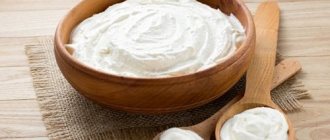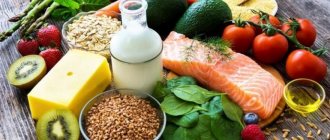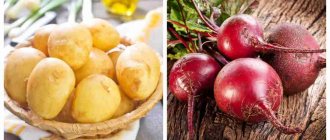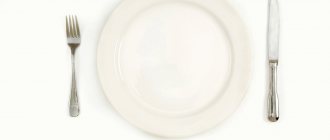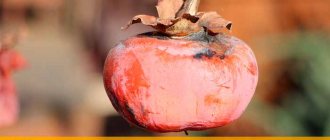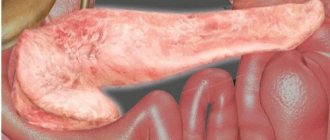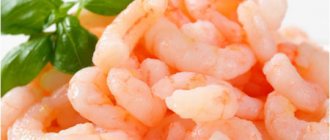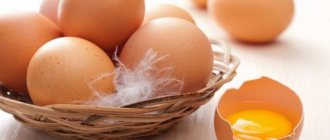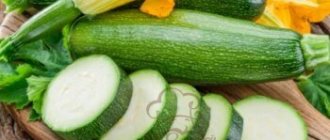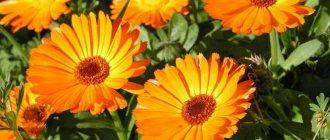Causes and symptoms of diseases
Diet really plays an important role in the treatment of these pathologies, because disruption of the normal functioning of the digestive tract most often occurs precisely because of poor nutrition.
Cholecystitis is an inflammation of the gallbladder that causes salt stones to form. They are the ones who contribute to blockage of the bile ducts, which entails the development of a pathological process. This defect is characterized by alternately subsiding and increasing pain in the area of the right hypochondrium.
But pancreatitis is usually a consequence of untreated cholecystitis. It appears against the background of increased secretion of secretions by the pancreas, due to which its mucous membrane suffers. If during the acute phase of the disease the patient refuses to take medications and follow a therapeutic diet, this can lead to serious complications, among which the most common is diabetes mellitus. That is why any person with such a diagnosis should know what to eat with pancreatitis and cholecystitis.
Do I need to follow a diet for pancreatitis?
nutrition during exacerbation of pancreatitis of the pancreas
The main component of treatment for exacerbation of pancreatitis is diet. When the acute phase of the disease develops, the patient's body needs complete rest. It is necessary to provide the pancreas with a significant reduction in its excretory function.
On the 1st day of the attack, the patient needs complete fasting. Food should be replaced with plenty of alkaline non-carbonated mineral water. It can be alternated with weak tea or rosehip decoction. The maximum daily dose is 2 liters.
The calorie content of dishes should be low. Eating overly heated or chilled food is prohibited.
The basis of the diet
Only by knowing what you can eat with cholecystitis and pancreatitis is it possible to maintain normal well-being and health, as well as prevent the progression of diseases. According to doctors, the first thing a patient with such a diagnosis should do is refuse:
- overeating;
- acute;
- fried;
- pickled;
- smoked;
- products containing acid;
- meat broths;
- food that is too cold or hot;
- sodas;
- alcoholic drinks.
Try to stick to fractional meals, that is, eat in small portions, but often. Each piece must be chewed carefully. And in order for food to be digested better, you should give preference to dishes that are steamed or baked, but without a dry crust. For pancreatitis and cholecystitis, it is very important to limit the consumption of carbohydrates and fats, but the intake of proteins, on the contrary, is encouraged.
Principles of an effective diet
To slow down the development of diseases of the gallbladder and pancreas, doctors advise their patients to adhere to an effective therapeutic diet, which is called table No. 5. Knowing what you can eat with cholecystitis and pancreatitis is necessary, first of all, in order to learn how to relieve the affected organs. With such diseases, they lose the ability to act harmoniously, but you can get rid of pain and discomfort on your own.
Dietary table No. 5 involves following several key rules.
- Regular meals, which consist of three full meals and several light snacks. Fasting and overeating should be avoided.
- You need to eat in small portions, which will be enough to not feel hungry. But at the same time they should not be high in calories.
- It is equally important to control the temperature of the food consumed. You should avoid overly hot and cold treats. Ideally, products should have a temperature of about 40 degrees.
- The foods consumed should not burden the digestive tract. It is worth giving up fibrous foods that contain a lot of fiber. During the cooking process, it is advisable to chop and grind all products to facilitate the functioning of damaged organs.
- Dishes can be prepared in a steamer, oven, or simply boiled, but under no circumstances should they be fried.
- Egg consumption should be reduced to 2-3 per week, and it is advisable to eat only the whites.
- The amount of coffee and tea in your diet should be limited, and alcohol should be completely avoided.
This diet is always recommended during remission.
Recommendations for fruit consumption
Fruits for pancreatitis can be consumed after an exacerbation, since during the initial stage (1-3 days) they can aggravate everything. The fact is that any fruit contains sugar, and some contain proteins. To break them down, the glandular cells of the human body will have to work hard, which is not particularly possible during cholecystitis and pancreatitis. At this time, their work is already disrupted, and the synthesis of enzymes must be minimized.
In the absence of dyspeptic disorders, you need to start drinking rosehip decoction without sugar, 100 ml 2 times a day. With positive functioning of the glands (liver and pancreas), the diet can begin to expand.
The consumption of lemon, sour varieties of apples, cherries, and currants is strictly prohibited. They cannot be consumed due to the acids contained in the composition, which, in turn, have an adverse effect on enzymes. You should also give up canned fruits, juices and compotes. They adversely affect the condition of the pancreas.
Features of the diet during the acute phase of the disease
What can you eat for cholecystitis and pancreatitis at the acute stage? At this stage, for the first 2-3 days it is best to refuse food altogether and only drink pure mineral water or rosehip decoction. The amount of liquid per day should not exceed a liter.
Over the next few days, doctors allow you to drink warm tea with toast, pureed soup, milk porridge, and a protein omelet made in a double boiler.
After a week, the diet can be supplemented with low-fat unleavened cottage cheese, vegetable broths or side dishes, for example, potatoes, carrots and beets.
At about 9-10 days, you can add white meat and fish, cooked in a double boiler, as well as dietary cutlets and meatballs to the menu.
The therapeutic diet should be followed for 8–12 months until a stable period of remission and a stable condition are achieved.
Finally
what to eat during exacerbation of pancreatitis
Menu for 7 days is approximately the same as the diet for day 6. Meals should be taken in a calm environment. You can't rush or stand while eating. You need to chew your food very carefully. Compote, tea, decoctions must be warm. Drinking cold water is prohibited.
Put a star:
Save it for yourself or share with friends: Save smart! DISCOUNTS FOR EVERYONE up to -90% ON EVERYTHING!
Features of diet for chronic pathologies
A special diet recommended for such a disease is necessary to restore normal activity of the pancreas and gall bladder. In this case, the patient is prohibited from eating foods that lead to increased production of bile and other enzymes. These include fried, salty, fatty, smoked foods, as well as alcohol and soda. You should completely avoid fast food and quick dry snacks.
In the chronic course of pathologies, it is very important to avoid overeating, which leads to increased stress on damaged organs. The quality of food is also considered equally important: all products must be fresh, and dishes must only be cooked.
Food that is difficult for the stomach to process should be excluded from the diet - it increases the production of digestive enzymes and contributes to the appearance of gases.
The daily menu for each patient is selected individually, depending on the severity of the pathology and the characteristics of the body. But in all cases, nutrition should be rational, moderate in calories and balanced.
Authorized Products
So, what can you eat for cholecystitis and pancreatitis:
- slightly dried or yesterday's white bread, with cereals or bran, cookies, dry biscuit;
- baked pies with cottage cheese, fish, meat and fruit;
- fresh dairy products with a minimum amount of fat;
- dairy and vegetarian soups without fried ingredients;
- first courses cooked in secondary low-fat broth can be eaten a maximum of twice during the week;
- dietary varieties of meat and fish, sausages, ham, seafood, boiled sausages;
- maximum 2 tablespoons per day of refined vegetable oils;
- oatmeal, rice, semolina and buckwheat, as well as small pasta;
- in some cases it is also allowed to eat pearl barley, barley, wheat and corn porridge;
- heat-processed vegetables and herbs;
- sweet berries and fruits without sourness, best processed;
- dried fruits;
- protein steam omelette;
- marshmallows, meringue, sweet jam, marshmallows, honey, caramel in minimal quantities;
- decoctions of herbs and rose hips, jelly, compotes, weak coffee and tea, preferably with milk, juices with water.
What can you eat
On a diet for cholecystopancreatitis, consumption of lean meat products is allowed. White dried bread is suitable for it. It is recommended to choose one with grains and bran, and it is better if it is yesterday's. The diet for cholecystopancreatitis includes non-acidic dairy products, which have a reduced fat content. We are talking about mild cheeses, dry cottage cheese, and yogurt. Milk should not have a fat content of more than 3.5%.
The diet for cholecystopancreatitis is often based on vegetarian soups without frying. Milk soup is also worth consuming. Soup with meat broth is allowed once or twice a week.
Meat products should not be fatty - you should choose rabbit, turkey, beef and skinless chicken. Seafood, ham, and boiled sausage are suitable. Be sure to include vegetable oil in your diet, but you should not add more than one or two spoons per day to your food. It is worth eating cereals and small pasta. The consumption of millet cereals and pearl barley is rarely allowed. Vegetables and greens are eaten after thermally treating them.
The menu includes non-acidic fruits and berries. It is best to pre-heat them. Dried fruits are also useful for patients with cholecystopancreatitis.
As a rule, doctors advise eating one egg per day in the form of an omelet.
Marshmallows, marshmallows, caramel products and honey are recommended in small dosages. Rosehip infusions and herbal infusions will be useful. If the patient drinks tea, it should not be strong. It is best to mix coffee and tea with milk, and compote, jelly, juice with water.
Prohibited Products
What you should avoid in case of any forms of pancreatitis and cholecystitis:
- fresh baked goods, sweet pastries and muffins;
- rich broths of fish and meat, sour cabbage soup, mushroom soups, okroshka;
- fatty meats and fish;
- herbs, hot spices and sauces, such as mustard and horseradish;
- canned fish and caviar;
- pates, smoked meats, marinades;
- fast food, store-bought crackers and chips, other snacks;
- fresh vegetables with coarse fibers and acids, for example, sorrel, green onions, radishes, legumes;
- sour fruits and berries;
- fatty confectionery and all kinds of sweets, especially with dyes and preservatives, including ice cream, cocoa powder and chocolate;
- alcohol;
- carbonated drinks;
- strong tea and coffee.
As you can see, such a diet imposes many restrictions, but you will have to follow it constantly. This is the only way to prevent regular exacerbations and pain.
What vegetables are possible for pancreatitis and cholecystitis?
Even with such diseases, many foods can and even should be eaten. It is only important to know exactly which vegetables are suitable for cholecystitis and pancreatitis, and which ones are best avoided in order to avoid troubles.
First of all, it is worth noting: whatever products you choose, remember that they must be fresh and of high quality. Vegetables should be ripe, but not overripe or spoiled.
Regardless of the form of the pathology, it is necessary to completely avoid the following products:
- garlic;
- radish;
- rhubarb;
- sorrel;
- salad;
- radish;
- Bell pepper;
- spinach;
- horseradish;
- onion;
- turnip.
All of these products are extremely dangerous for diseases of the pancreas and gall bladder.
Can I have sauerkraut for pancreatitis and cholecystitis? Definitely not. This dish is too sour and promotes increased enzyme production, which aggravates the disease. Even if you really want to treat yourself to your favorite treat, you should not neglect your doctor’s instructions and relax - the consequences can be unpredictable.
But is it possible to eat beets for cholecystitis and pancreatitis? Yes, this vegetable helps to cleanse the body, activate relevant processes, and also enrich the blood and internal organs with useful substances.
In addition to beets, for such pathologies, doctors recommend supplementing the daily diet with:
- potatoes;
- zucchini;
- pumpkin;
- cauliflower;
- carrots.
All these vegetables contain a huge amount of useful microelements that support the functioning of internal organs and systems.
What diet is needed for cholecystitis and pancreatitis and what sample menu is used?
Diet for pancreatitis and cholecystitis is very important. Without certain restrictions in the diet, treatment with medications will not give the desired effect. Dysfunction of the organs and systems of the digestive tract is most often provoked by poor nutrition and consumption of harmful foods (fast food, fatty, spicy and fried foods).
The benefits and harms of some products
- Milk for cholecystitis and pancreatitis. If these pathologies are chronic, then drinking milk is allowed. But you will have to give up condensed milk, cheeses and ice cream forever. During an exacerbation, you can start consuming dairy products only on the third day. At the same time, they need to be diluted with water or cooked from them into porridge. During the period of remission, milk is considered an essential product. Is it possible to have kefir for cholecystitis and pancreatitis? Doctors usually only allow the one percent product for patients. For pancreatitis and cholecystitis, kefir can be replaced with yogurt or fermented baked milk.
- Nuts. These products provide enormous benefits due to the beneficial substances in their composition: resveratrol, vitamin E, lutein, carotene, fatty acids. The supply of these elements is especially important in case of cholecystitis and pancreatitis. But their consumption should also be limited to prevent increased stress on the organs. The daily intake of any nuts should not exceed 20 g.
- Honey. Is it possible to treat yourself to this delicious delicacy if you have pancreatitis and cholecystitis? The beneficial qualities of the bee product are actually difficult to overestimate, but in case of such pathologies it must be used with caution. During exacerbations, you will have to give up honey completely. But at the remission stage, in moderate quantities, this product can improve the patient’s condition and his overall well-being.
- Persimmon. Is it possible to eat this tasty fruit for cholecystitis and pancreatitis? If you use persimmon in moderation, it will bring exceptional benefits due to the content of many useful substances in its composition. But this only applies to periods of remission. The fruits should be eaten without peeling, preferably baked. By the way, persimmon perfectly suppresses hunger and has a positive effect on a person’s appearance and the state of his immunity.
- Melon. Is it possible to treat yourself to such a delicious delicacy if you have pancreatitis and cholecystitis? In fact, this fruit contains a large amount of fiber, which is prohibited in such pathologies. Therefore, people with this diagnosis will have to refrain from consuming melon, especially during an exacerbation period. However, some doctors say that during remission you can still please yourself with a small amount of this fruit. True, you can only eat melon in the form of puree. The maximum allowed amount per day is 400 g.
- Avocado. Not many people like such an exotic product. However, it will be useful for people suffering from diseases of the pancreas and gall bladder to know whether avocado is ok for pancreatitis and cholecystitis. In case of acute inflammation, this delicacy is contraindicated, as it contributes to irritation of the affected organs. In addition, avocados contain a large amount of fiber, which provokes the appearance of flatulence, constipation, increased peristalsis and a general exacerbation of pathology. So you need to give it up forever.
- Seeds. Is it possible to consume pumpkin or sunflower seeds if you have cholecystitis and pancreatitis? As for the latter, all doctors unanimously prohibit it. After all, sunflower seeds contain too much fat. But pumpkin seeds can be consumed only under one condition - they must be dried in the oven or in the sun, but definitely not in a frying pan.
General principles of nutrition for patients with cholecystitis and pancreatitis
These diseases should be considered together, since very often the pathology of the gallbladder is combined with improper functioning of the pancreas, and vice versa. This is due to the close location of the organs, as well as the passage of the common bile duct directly into the thickness of the pancreas.
The fundamental principle of the diet for cholecystitis and pancreatitis is frequent meals at certain hours. In the work of the gastrointestinal tract, neuro-reflex mechanisms play a large role, and the digestive system gets used to a certain diet.
So, if the patient is used to eating at 8:00, 15:00 and 18:00, then it is during these hours that the work of the digestive tract will be maximum. If this person skips a daily meal, then his body will still tune in to digestion. Obviously, fasting at this time will have a negative impact on your health. That is why the diet of patients with chronic cholecystitis, especially during an exacerbation, should be scheduled literally by the hour.
Another important principle is eating small portions. If a person constantly suffers from overeating, this will lead not only to excess weight, but also to excessive stimulation of the gallbladder and pancreas, which often ends in another attack.
Menu for the week
With the right approach to treatment and following a diet, you can significantly alleviate the clinical picture and even speed up the recovery process. A sample menu for the week will help you with this.
- Monday. For breakfast you can eat oatmeal, biscuits and drink weak tea without sugar. For lunch, light soup with vegetables, boiled chicken, stewed vegetables and herbal tea are suitable. For dinner, eat boiled vegetables, a portion of lean fish and fruit jelly.
- Tuesday. For breakfast, eat a steamed protein omelet, boiled vegetables and drink rosehip tea. For lunch - rich chicken broth with vegetables, boiled veal with buckwheat and fruit jelly. For dinner - vegetable salad, rice pudding and a cup of tea without sugar.
- Wednesday. Eat a couple of cheesecakes and currant tea for breakfast. For lunch, serve soup with cereals, vegetable pilaf and fruit jelly. For dinner - cottage cheese casserole, baked apple and low-fat yogurt.
- Thursday. For breakfast, give preference to noodles with low-fat cheese and tea without sugar. For lunch, eat vegetable soup with meatballs, oatmeal with steamed fish and sweet berry compote. For dinner - mashed potatoes with a steamed cutlet and herbal infusion.
- Friday. For breakfast, serve a steamed omelette with carrots, cauliflower and spinach, biscuits and dried fruit compote. For lunch - lean borscht without cabbage, vegetable stew with chicken and a glass of one percent kefir. For dinner - buckwheat with boiled fish, vegetable salad and fruit jelly.
- Saturday. For breakfast, eat cottage cheese casserole with dried or candied fruits, an unleavened bun and drink herbal tea. For lunch - pureed vegetable soup, chicken meatballs with rice and cocoa with milk. For dinner - fruit salad and green tea without sugar.
- Sunday. For breakfast, serve oatmeal, sauteed vegetables, a piece of low-fat cheese and herbal tea. For lunch - chicken broth with vegetables, minced meat and noodle casserole, berry juice. For dinner, eat fish soufflé, vegetable salad and drink low-fat milk.
